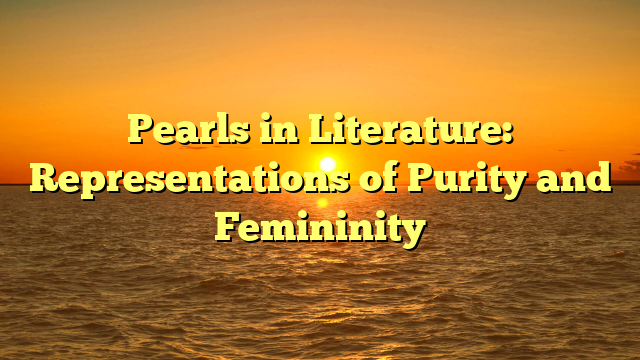
Pearls have long held a special place in human culture, symbolizing elegance, wealth, and timeless beauty. In samosir88 , these luminous gemstones often serve as powerful symbols, representing themes such as purity, femininity, and spiritual refinement. Across centuries, writers have used pearls to convey nuanced ideas about characters, societal expectations, and the ideals of beauty and virtue. This article delves into the literary significance of pearls, exploring how they have come to embody purity and femininity in diverse cultural contexts.
Pearls as Symbols of Purity
One of the most enduring associations of pearls in literature is their connection to purity. Their immaculate whiteness, smooth surface, and natural formation make pearls a fitting metaphor for innocence and untainted virtue. In classical and religious texts, pearls are often linked to moral purity and divine grace.
In the Bible, pearls symbolize spiritual enlightenment and the Kingdom of Heaven. The phrase “pearl of great price” (Matthew 13:46) refers to something of immeasurable value, equating the purity of pearls with the sanctity of faith and devotion. This association with moral perfection has influenced literary depictions of pearls as markers of characters’ inner virtue.
For example, in Nathaniel Hawthorne’s *The Scarlet Letter*, the character Pearl, the illegitimate daughter of Hester Prynne, is named after the gemstone. Although she is born out of sin, Pearl represents an untainted innocence and becomes a living symbol of her mother’s redemption. Her name underscores the notion that purity is not solely a matter of societal judgment but also an inner truth that transcends external circumstances.
### **Pearls and Femininity
Pearls are frequently associated with femininity, often representing ideals of beauty, grace, and refinement. In many literary works, female characters adorned with pearls are portrayed as embodiments of elegance and sophistication. This symbolic connection highlights societal expectations placed upon women, particularly in historical contexts where beauty and virtue were intertwined.
F. Scott Fitzgerald’s *The Great Gatsby* offers a vivid example of pearls as markers of femininity and wealth. Daisy Buchanan, a central character in the novel, is often associated with pearls. Her pearl necklace, a gift from her wealthy husband, Tom, symbolizes the material wealth and societal privilege that define her life. However, the pearls also serve as a subtle critique of the constraints imposed on women, as Daisy’s choices are shaped by societal expectations rather than personal desires.
Pearls as Dual Symbols
While pearls often signify purity and femininity, they can also carry more complex or contradictory meanings in literature. Depending on the context, pearls may symbolize fragility, vanity, or even sorrow. The phrase “casting pearls before swine,” originating from the Bible, suggests the futility of offering something precious to those who cannot appreciate its value. This duality underscores the deeper layers of meaning that pearls can hold in literary narratives.
In Shakespeare’s Othello, Desdemona’s handkerchief, described as “spotted with strawberries,” contains threads woven from silk and pearls. The pearls, symbolizing Desdemona’s purity and love, ultimately become entangled in the tragedy of jealousy and betrayal. Here, pearls take on a more ironic tone, representing the fragility of ideals in the face of human flaws.
The symbolic richness of pearls in literature reflects their timeless appeal and cultural significance. Whether representing purity, femininity, or the complexities of human nature, pearls have served as powerful literary devices for exploring profound themes. Their enduring presence in literature speaks to their universal resonance, offering readers a lens through which to examine societal values, personal identity, and the intricate interplay between appearance and reality.
As symbols of both simplicity and sophistication, pearls continue to captivate the literary imagination, shining as metaphors for the qualities that make us uniquely human. Through their multifaceted representations, pearls remind us that true beauty often lies in the depths of meaning beneath the surface.





